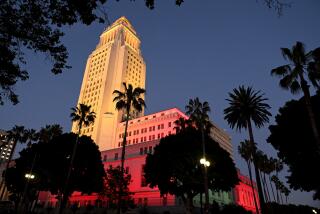Civic Center Revival Plans Try to Polish a ‘Diamond’ in the Rough
A billion-dollar development boom is underway in the Civic Center, fueled by the need for new or upgraded government office space.
The city, county, state and federal governments all have plans for the Civic Center area. Close to 40 projects are under discussion for the next decade or so, said Dan Rosenfeld, assistant general manager of the city’s Department of General Services, charged with managing the city’s real estate.
It’s possible that not all of the needed new government offices will be located downtown, but Rosenfeld and others are trying to encourage it in hopes of rejuvenating the Civic Center with new life and a new look.
“Do I think every one is going to happen? No,” said Rosenfeld. “But at least two-thirds will proceed, and of those projects we hope at least two-thirds will go into the Civic Center.
“Whether it happens in a planned, intelligent way is the question.”
Because each level of government is independent, each can decide where to locate without coordination. The hope is for cooperation so that as projects are developed they contribute to the new Civic Center.
Already underway are seismic rehabilitation of City Hall and work on the Municipal Water District headquarters, the federal courthouse at 312 N. Spring St. and the 300 N. Los Angeles St. federal building.
Up next, the Immigration and Naturalization Service is searching for a building site.
With 33,000 employees, the Los Angeles Civic Center is said to be the second-largest government center outside Washington, D.C.
There is nothing to make the many levels of government here work together. Through a breakfast club Rosenfeld started, the real estate staffs of the various branches of government realized they share similar problems and needs.
But, Rosenfeld said, “every government is sovereign so it becomes like anything in politics, a matter of persuasion and self-interest, and the biggest self-interest here is cost-saving.
“We found 11 vehicle maintenance yards owned by government within a mile of City Hall. We found 28 cafeterias. Every one of those that can be eliminated is money in the pocket of government. The real test here is political leadership.”
The Central City Assn., a private organization of downtown interests, was active in getting the city and county to revive the Civic Center Authority, which had not met in 14 years, to promote cooperation.
Co-chaired by city Councilwoman Rita Walters and county Supervisor Gloria Molina, the group includes representatives of state and federal government, the Los Angeles Unified School District and other agencies that participate but are not members.
The authority commissioned a planning team led by landscape architect Lauren Melendrez, architect William H. Fain Jr., urban designer Douglas R. Suisman, architect R. Steven Lewis and realty analyst Charles Loveman to create a master plan.
Its Civic Center Shared Facilities and Enhancement Plan--referred to as the “10-Minute Diamond”--goes to the Civic Center Authority for approval next month.
The 10-Minute Diamond promotes a pedestrian-oriented Civic Center district, with City Hall as the center point and the boundaries defined by a 10-minute walk in each direction.
*
The four quadrants of the district emphasize the historic and topographical character of the site: the Hillside Quarter on Bunker Hill; the Old Pueblo Quarter, with the historic plaza and mission; New Town Quarter, where the business district sprang up, and the Riverbed Quarter, once vineyards and cornfields beside the Los Angeles River.
The plan envisions more people-friendly, income-generating uses such as Pasqua, a small coffee and sandwich kiosk with outdoor tables on the courthouse mall. Each quadrant of the diamond incorporates a dominant open-space element designed for pedestrians--revamping the Civic Center mall into a park and creating a new Civic Square plaza next to City Hall, a network of paseos leading to Little Tokyo and an avenue of arcades, called portales, running east to the historic El Pueblo.
“One of the most important projects we hope to get out to bid in 1997 is a bridge over the Santa Ana Freeway to connect City Hall and Olvera Street with retail shops,” said Rosenfeld.
In another phase, the sunken Los Angeles Mall on Main Street would be brought up to street level and continue the arcades all the way to City Hall East.
Other projects proposed or in the planning stages include renovating or moving the Parker Center police headquarters, reconfiguring the original Broadway department store on Broadway and looking for a new home for the Caltrans offices on Spring Street.
Public Places writer Jane Spiller welcomes comments and ideas. Contact her c/o NEXT L.A. or at Jane.Spiller@latimes.com
(BEGIN TEXT OF INFOBOX / INFOGRAPHIC)
Plan for Downtown
This artist’s view of proposed Civic Center enhancements shows a pedestrian- oriented district with all sites within a 10- minute walk of the central point, City Hall.
*
Hillside Quarter: Botanic Gardens linking Music Center to City Hall.
Old Pueblo Quarter: “Portals” (covered sidewalks) linking City Hall to Olvera Street, via a shop- lined bridge over the Santa Ana Freeway.
New Town Quater: Civic Square linking City Hall to the Reagan State Building.
Riverbed Quarter: “Paseo” (walkway) linking City Hall to Geffen Museum and Little Tokyo.
Source: Drawing by DOUG SUISMAN
More to Read
Sign up for Essential California
The most important California stories and recommendations in your inbox every morning.
You may occasionally receive promotional content from the Los Angeles Times.










